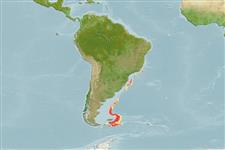>
Perciformes/Zoarcoidei (Eelpouts and pricklebacks) >
Zoarcidae (Eelpouts) > Lycodinae
Etymology: Lycodonus: Derived from Greek, Lykos = wolf + Greek, onos = hake; malvinensis: Named after the Malvinas Islands Archipelago in the Western South Atlantic, its type locality (Ref. 85841).
Environment: milieu / climate zone / depth range / distribution range
Écologie
marin bathydémersal; profondeur 800 - 2044 m (Ref. 11954). Deep-water
Southwest Atlantic: known only from the continental slope east of the Malvinas Islands (Falkland Islands).
Taille / Poids / Âge
Maturity: Lm ? range ? - ? cm
Max length : 19.6 cm SL mâle / non sexé; (Ref. 11954)
Description synthétique
Clés d'identification | Morphologie | Morphométrie
Rayons mous dorsaux (Total) : 101 - 103; Rayons mous anaux: 96 - 98; Vertèbres: 113. This species is distinguished by the following set of characters: 6-9 'free' (i.e., non-ray-bearing) bony scutes in front of dorsal fin; anteriormost dorsal scute closer to the base of pectoral fins than to their tips; mid-part of the bony scutes in dorsal fin and hinder part of anal fin produced as a blunt spine; D 101-103; A 96-98; neural spines of anterior caudal vertebrae very short, less than half the depth of the vertebra (Ref. 85841).
Life cycle and mating behavior
Maturité | Reproduction | Frai | Œufs | Fécondité | Larves
Anderson, M.E., 1994. Systematics and osteology of the Zoarcidae (Teleostei: Perciformes). Ichthyol. Bull. J.L.B. Smith Inst. Ichthyol. 60:120 p. (Ref. 11954)
Statut dans la liste rouge de l'IUCN (Ref. 130435: Version 2024-1)
Menace pour l'homme
Harmless
Utilisations par l'homme
Outils
Articles particuliers
Télécharger en XML
Sources Internet
Estimates based on models
Preferred temperature (Ref.
123201): 2.2 - 3.5, mean 2.5 °C (based on 30 cells).
Phylogenetic diversity index (Ref.
82804): PD
50 = 0.5625 [Uniqueness, from 0.5 = low to 2.0 = high].
Bayesian length-weight: a=0.00120 (0.00058 - 0.00248), b=3.10 (2.91 - 3.29), in cm total length, based on LWR estimates for this (Sub)family-body shape (Ref.
93245).
Niveau trophique (Ref.
69278): 3.5 ±0.5 se; based on size and trophs of closest relatives
Résilience (Ref.
120179): Milieu, temps minimum de doublement de population : 1,4 à 4,4 années (Preliminary K or Fecundity.).
Fishing Vulnerability (Ref.
59153): Low vulnerability (14 of 100).
